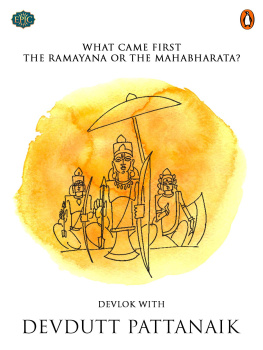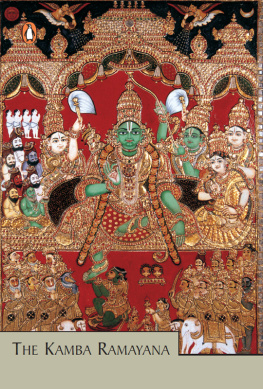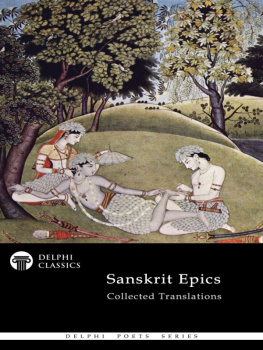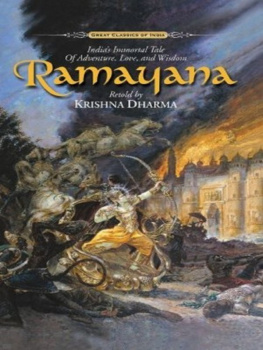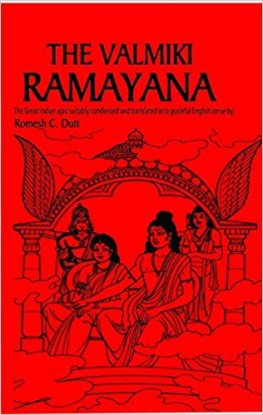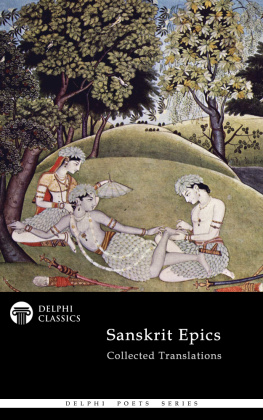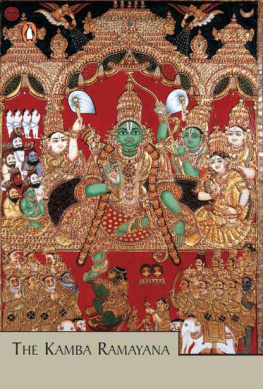Table of Contents

THE RAMAYANA
R. K. NARAYAN was born on October 10, 1906, in Madras, South India, and educated there and at Maharajas College in Mysore. His first novel, Swami and Friends (1935), and its successor, The Bachelor of Arts (1937), are both set in the fictional territory of Malgudi, of which John Updike wrote, Few writers since Dickens can match the effect of colorful teeming that Narayans fictional city of Malgudi conveys; its population is as sharply chiseled as a temple frieze, and as endless, with always, one feels, more characters round the corner. Narayan wrote many more novels set in Malgudi, including The English Teacher (1945), The Financial Expert (1952), and The Guide (1958), which won him the Sahitya Akademi (Indias National Academy of Letters) Award, his countrys highest honor. His collections of short fiction include A Horse and Two Goats , Malgudi Days , and Under the Banyan Tree . Graham Greene, Narayans friend and literary champion, said, He has offered me a second home. Without him I could never have known what it is like to be Indian. Narayans fiction earned him comparisons to the work of writers including Anton Chekhov, William Faulkner, O. Henry, and Flannery OConnor.
Narayan also published travel books, volumes of essays, the memoir My Days , and the retold legends Gods, Demons, and Others , The Ramayana, and The Mahabharata . In 1980 he was awarded the A. C. Benson Medal by the Royal Society of Literature, and in 1981 he was made an Honorary Member of the American Academy of Arts and Letters. In 1989 he was made a member of the Rajya Sabha, the nonelective House of Parliament in India.
R. K. Narayan died in Madras on May 13, 2001.
PANKAJ MISHRA is the author of The Romantics, winner of the Los Angeles Times s Art Seidenbaum Award for First Fiction, An End to Suffering: The Buddha in the World , and Tempations of the West: How to be Modern in India, Pakistan, Tibet, and Beyond . He is a frequent contributor to the New York Times Book Review, the New York Review of Books, and the Guardian .

PENGUIN BOOKS
Published by the Penguin Group
Penguin Group (USA) Inc., 375 Hudson Street, New York, New York 10014, U.S.A.
Penguin Group (Canada), 90 Eglinton Avenue East, Suite 700, Toronto,
Ontario, Canada M4P 2Y3 (a division of Pearson Penguin Canada Inc.)
Penguin Books Ltd, 80 Strand, London WC2R 0RL, England
Penguin Ireland, 25 St Stephens Green, Dublin 2, Ireland (a division of Penguin Books Ltd)
Penguin Group (Australia), 250 Camberwell Road, Camberwell,
Victoria 3124, Australia (a division of Pearson Australia Group Pty Ltd)
Penguin Books India Pvt Ltd, 11 Community Centre, Panchsheel Park, New Delhi - 110 017, India
Penguin Group (NZ), cnr Airborne and Rosedale Roads, Albany,
Auckland 1310, New Zealand (a division of Pearson New Zealand Ltd)
Penguin Books (South Africa) (Pty) Ltd, 24 Sturdee Avenue,
Rosebank, Johannesburg 2196, South Africa
Penguin Books Ltd, Registered Offices:
80 Strand, London WC2R 0RL, England
First published in the United States of America by The Viking Press 1972
First published in Great Britain by Chatto & Windus 1973
Published in Penguin Books (U.S.A.) 1977
Published in Penguin Books (U.K) 1977
This edition with an introduction by Pankaj Mishra published in Penguin Books (U.S.A.) 2006
Copyright R. K. Narayan, 1972
Introduction copyright Pankaj Mishra, 2006
All rights reserved
The decorations, drawn from Indian temple sculptures, are by R. K. Laxman.
LIBRARY OF CONGRESS CATALOGING IN PUBLICATION DATA
Narayan, R. K., 1906-2001.
The Ramayana : a shortened modern prose version of the Indian epic (suggested by the Tamil version of
Kamban) / R.K. Narayan ; introduction by Pankaj Mishra.
p. cm.(Penguin classics)
eISBN : 978-0-143-03967-9
1. Rama (Hindu deity)Fiction. 2. Epic literature, TamilAdaptations. I. Kampar, 9th cent.
Ramayanam. II. Title. III. Series.
PR9499.3.N3R36 2006
297.5922dc22 2006045201
The scanning, uploading and distribution of this book via the Internet or via any other means
without the permission of the publisher is illegal and punishable by law. Please purchase
only authorized electronic editions, and do not participate in or encourage electronic
piracy of copyrighted materials. Your support of the authors rights is appreciated.
http://us.penguingroup.com
Introduction
In the summer of 1988 sanitation workers across North India went on strike. Their demand was simple: they wanted the federal government to sponsor more episodes of a television serial based on the Indian epic Ramayana (Romance of Rama). The serial, which had been running on Indias state-owned television channel for more than a year, had proved to be an extraordinarly popular phenomenon, with more than eighty million Indians tuning in to every weekly episode. Streets in all towns and cities emptied on Sunday mornings as the serial went on the air. In villages with no electricity people usually gathered around a rented television set powered by a car battery. Many bathed ritually and garlanded their television sets before settling down to watch Rama, the embodiment of righteousness, triumph over adversity.
When the government, faced with rising garbage mounds and a growing risk of epidemics, finally relented and commissioned more episodes of The Ramayana, not just the sanitation workers but millions of Indians celebrated. More than a decade and many reruns later, the serial continues to inspire reverence among Indians everywhere, and remains for many the primary mode of experiencing Indias most popular epic.
The reasons for this may not be immediately clear to an uninitiated outsider: the serial, cheaply made by a Bollywood filmmaker, abounds in ham acting and tinselly sets, and the long, white beards of its many wise, elderly men look perilously close to dropping off.
But it wasnt so much its kitschy, Bollywood aspect that endeared the serialization to Indians as its invoking of what is easily the most influential narrative tradition in human history: the story of Rama, the unjustly exiled prince. It may be impossible to prove R. K. Narayans claim that every Indian is aware of the story of The Ramayana in some measure or other. But it will sound true to most Indians. Indeed, the popular appeal of the story of Rama among ordinary people distinguishes it from much of Indian literary tradition, which, supervised by upper-caste Hindus, has been forbiddingly elitist.
There is really no Western counterpart in either the Hellenic or Hebraic tradition to the influence that this originally secular story, transmitted orally through many centuries, has exerted over millions of people. The Iliad and The Odyssey are, primarily, literary texts, but not even Aesops fables or the often intensely moral Greek myths shape the daily lives of present-day inhabitants of Greece. In contrast, The Ramayana continues to have a profound emotional and psychological resonance for Indians.
By invoking the utopian promise of Rama-Rajya (kingdom of Rama), Gandhi attracted a large mass of apolitical people to the Indian freedom movement against the British. Postcolonial India may not resemble Rama-Rajya, but the emotive appeal of Ramayana seems to be undiminished, and often vulnerable to political exploitation: in the late eighties and early nineties, the Hindu nationalist movement to build a temple on the alleged birthplace of Rama claimed thousands of lives across India.
Next page



